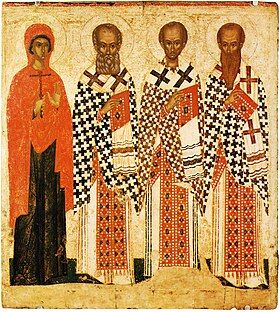Parascheva of the Balkans
| Saint Paraskeva of the Balkans | |
|---|---|

|
|
| Born | Epivates |
| Died | 11th century Katikratia |
| Venerated in | Eastern Orthodox Church |
| Major shrine | Metropolitan Cathedral of Iaşi, Romania ; Church of St Paraskeva, Nesebar |
| Feast | October 14 |
| Patronage | embroiderers, needle workers, spinners, weavers, marriage |
Saint Paraskeva of the Balkans (also known as: Petka of Macedonia, Paraskeva of Serbia, Paraskeva the Serbian, Paraskeva of Belgrade, Parascheva the New, Parascheva the Young, Ancient Greek: Ὁσία Παρασκευή ἡ Ἐπιβατινή, Modern Greek: Οσία Παρασκευή η Επιβατινή ή Νέα, Serbian: Sveta Petka or Serbian: Petka Paraskeva, Paraskeva Pyatnitsa, Parascheva of Tirnovo) was an ascetic female saint of the 10th century.
She was born in the town of Epivates (close to today's Istanbul) on the shore of the Sea of Marmara; her parents were wealthy landowners. A church, dedicated to her, had been built in Selimpaşa on the spot where her house of birth once stood. The oldest testimony regarding the church dates back to the year 1200. It was written by the Russian voyager Anthony, Bishop of Novgorod. In August 1817 the church was completely destroyed by a great fire, and it was rebuilt in 1820, with the financial support of the citizens of Constantinople and the Governor of Moldo-Wallahia, Prince Alexander Kallimachi. In 1885 the Community demolished the old church in order to construct a much bigger one on the same place. The building was completed after 6 years, for which parts of the Byzantine tower of Duke Alexis Apokaukos (1327–41) were re-used as building material. It was the biggest church of whole Eastern Thrace (16 m height, 26 m width and 30 m length), a real jewel that in could be seen from kilometres away.It was completely demolished in the spring of 1979,and now in the same place there is a park. The legend says that when she was a child, Paraskeva heard in a church the Lord's words: "Whoever wants to come after Me, let him deny himself, and take up his cross, and follow Me." (Mark 8, 34). These words would determine her to give her rich clothes away to the poor and flee to Constantinople. Her parents, who did not support her decision to follow an ascetic, religious life, looked for her in various cities. Paraskeva fled to Chalcedon, and afterwards lived at the church of the Most Holy Theotokos in Heraclea Pontica. She lived an austere life, experiencing visions of the Virgin Mary. Her voyages took her to Jerusalem, wishing to spend the rest of her life there. After seeing Jerusalem, she settled in convent in the river Jordanian desert.
...
Wikipedia
